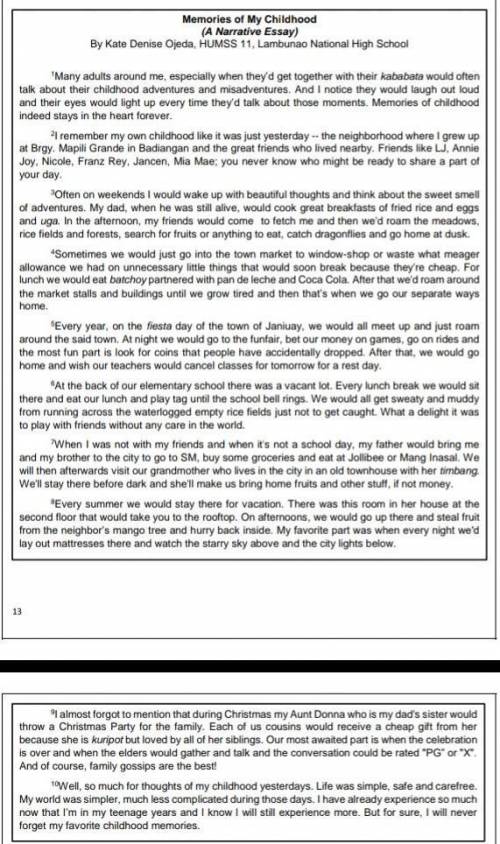INTRODUCTION
1. Introduce the subject of your critique – the
reading under analysis. M...

English, 03.12.2021 06:50 elrodkaitlynn2965
INTRODUCTION
1. Introduce the subject of your critique – the
reading under analysis. Make sure to name the
work being reviewed, as well as the date when
it was created, as well as the name of the
creator.
2. Describe the main argument or purpose of
the work.
3. Explain the context in which the work was
created. This can be a social or political context.
Review the background facts or issues that
must be understood before the point of the
reading can be appreciated: significance,
design, appeal, and so on.
You may also discuss the place of the work in a
creative or academic tradition, or the
relationship between the work and creator’s life
experience.
4. Review the assumptions in the reading that
must be understood before you take a position.
5. Make an umbrella statement that can give the
reader a sign as to what your evaluation is going
to be. For instance, it may indicate whether it is
positive, negative, or a mixed evaluation. In
doing this, make your position statement clear:
what is your evaluation? On what basis are you
making it, given what you have stated in #3 and
#4?
BODY
6. The critical evaluation section
What different elements of the work were
evaluated?
7. Was the critique writer able to provide evidence
from the work itself? Give examples.
CONCLUSION
8. State your conclusions, reminding the reader
of the points you have made and your reasons
for making them.


Answers: 1
Another question on English

English, 21.06.2019 13:00
Describe thomas jefferson purpose for writing the declaration of independence.then analyze how his use of pathos develop this purpose. be sure to use specific details from the text to support your ideas.
Answers: 1

English, 21.06.2019 15:10
Which excerpt from tinker v. des moines shows how precedent support an argument? a. "as we shall discuss, the wearing of armbands in the circumstances of this case was entirely divorced from actually or potentially disruptive conduct by those participating in it. it was closely akin to 'pure speech' which, we have repeatedly held, is entitled to comprehensive protection under the first amendment. cf. cox v. louisiana, 379 u.s. 536, 555 (1965); adderley v. florida, 385 u.s. 39 (1966)." b. "while the absence of obscene remarks or boisterous and loud disorder perhaps justifies the court's statement that the few armband students did not actually 'disrupt' the classwork, i think the record overwhelmingly shows that the armbands did exactly what the elected school officials and principals foresaw they would." c. "i, for one, am not fully persuaded that school pupils are wise enough, even with this court's expert from washington, to run the 23,390 public school systems [n4] in our 50 states." d. "under our constitution, free speech is not a right that is given only to be so circumscribed that it exists in principle, but not in fact. freedom of expression would not truly exist if the right could be exercised only in an area that a benevolent government has provided as a safe haven for crackpots."
Answers: 1

English, 22.06.2019 03:00
Need answer asap plz! the descriptions of the west wind in the first two sections of “ode to the west wind” are dominated by images of a. violence, death, decay, and burial. c. peace, birth, growth, and blossoming. b. sleep, dreams, fantasy, and reverie. d. translucence, light, color, and radiance.
Answers: 1

English, 22.06.2019 06:30
50 ! your poem must include the following: ● poetic form: lines and stanzas (not paragraphs! ) o your poem needs to be at least 10 lines long. ● sensory details/strong imagery o “paint a picture” and/or create an emotion with your words, word choice is key in poetry ● figurative language o include at least one of the following: metaphor, simile, and/or personification (click here for more info. on these) ● sound devices o include at least one of the following: repetition, rhyme, rhythm, meter, onomatopoeia, and/or alliteration (click here for more info. on these) ● labels o underneath your poem, include the words from the poem that represent the figurative language and sound devices and label them o examples: booming bombs - alliteration; like a firefly - simile you so
Answers: 1
You know the right answer?
Questions

Mathematics, 19.04.2021 02:10

Mathematics, 19.04.2021 02:10


Mathematics, 19.04.2021 02:10



Mathematics, 19.04.2021 02:10

SAT, 19.04.2021 02:10




History, 19.04.2021 02:10


Engineering, 19.04.2021 02:10

Mathematics, 19.04.2021 02:10

Mathematics, 19.04.2021 02:10


History, 19.04.2021 02:10

Mathematics, 19.04.2021 02:10



